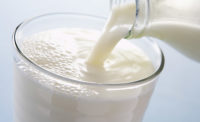
Facing Organic Perceptions: All Milk Is Safe And
Wholesome
by Jean Ragalie
Why are some consumers
willing to pay so much more for organic milk? While organic milk purchases
still represent less than 2 percent of total fluid milk purchases, recent
data from Chicago-based Information Resources Inc. (IRI) data suggests
retail sales of organic milk grew 27 percent last year. This impressive
growth is occurring despite the fact that the retail price of organic milk
is roughly twice that of conventional milk.
Recent consumer research conducted by the National
Dairy Council appears to indicate that perception is driving this growth.
Organic milk drinkers view the product as more pure, more natural and
healthier, particularly for children. They cite concerns over added
hormones, on-farm use of antibiotics and pesticides, and perceived
additives to conventional milk. Some organic consumers also claim that
organic milk has a creamier and lighter mouth feel and that it tastes
“cleaner,” “fresher” and “more
natural.” Some express concerns over how conventional animals are
raised, and express a preference for “sustainable agriculture”
feeding and animal care practices.
Given this mindset among a growing number of
consumers, a basic question the entire dairy industry must answer for the
public is whether organic milk is healthier, more nutritious or safer than
conventional milk.
The answer is no — both organically and
conventionally produced milk naturally contain protein, calcium and other
important nutrients. Organic or conventional, all milk is nutritious, safe
and wholesome.
This position is supported not only by the National
Dairy Council, but also by the U.S. Department of Agriculture (USDA),
International Dairy Foods Association (IDFA) and the American Dietetic
Association (ADA), which represents about 70,000 dietitians across the
country.
Look at the Nutrition Facts label and you will see
that each serving of milk offers the same amount of nine essential
nutrients, including calcium, vitamin D and potassium.
In regards to animal welfare, it’s important to
remember that dairy farmers take great care with their animals, and if one
becomes ill, they will treat her with the utmost concern and care until the
animal recovers.
Regarding safety, all milk must comply with very
stringent safety standards. Any raw milk that tests positive for
antibiotics is discarded, never reaching the consumer.
What, then, is the difference between organic milk and
conventional milk? As with all organic foods, it’s the process, not
the final product, that makes milk “organic” or
“conventional.”
According to USDA standards, milk and dairy products
can be labeled “organic” if the milk comes from cows that have
been exclusively fed organic feed, are kept in pens with adequate space,
are allowed periodic access to the outdoors and direct sunlight, are not
treated with synthetic hormones and are not given certain medications to
treat illness. Organic feed is harvested from fields that have adhered to
the USDA’s organic regulations for pesticides and fertilizers for at
least three years. Food marketers who use the term “organic”
must ensure that all of the above criteria are met, and must follow federal
Food and Drug Administration (FDA) labeling guidelines.
Dairy industry marketers often receive questions from
consumers about organic milk and conventional milk. National Dairy Council,
National Milk Producers Federation and International Dairy Foods
Association, upon consultation with government agencies and independent
scientists, worked together to develop answers to some of the most common
questions. The information is posted at www.nationaldairycouncil.org.
Jean Ragalie, R.D., is executive vice president of
public, nutrition and corporate affairs for the National Dairy Council.
$OMN_arttitle="Facing Organic Perceptions: All Milk Is Safe And Wholesome";?>
